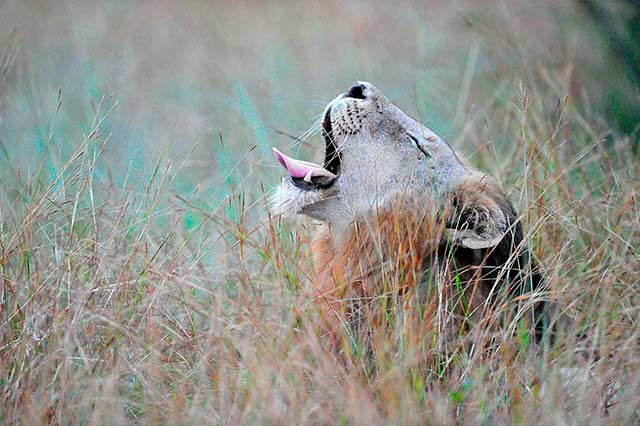
© 2013 Mario Fazekas. All rights reserved.
Lion Yawn – Kruger National Park
Nikon D3S with Nikon 600mm f4 lens on Apex beanbag. ISO 12800, f/4 @ 1/1000 sec.
An African safari is and incredible experience for all, but it’s even more exciting when your passion is wildlife photography. We have asked many photographers what their biggest challenge is when going on African photo safaris and these are some of the answers we have heard:
2. I don’t have enough reach as the subjects are too far away.
3. I cannot afford a professional lens.
4. My photos taken in low-light are blurred.
5. Getting the subject in sharp focus is difficult.
6. Photographing birds in fight is hard for me.
7. I want to get closer to the subject.
8. The animals don’t do anything interesting.
The above seven challenges relate to equipment, technique and understanding animal behaviour, which can all be learned, but we have found the Number 1 Challenge in wildlife photography has nothing to with photography – it is finding the animals!
If you cannot locate the wildlife subjects, then all that’s left to photograph is the landscape. Beautiful as it is, it’s the wildlife that you have come to see.
Keep in mind that national parks are not zoos – they are huge tracts of wilderness where the animals roam freely. In addition, some animals, like the leopard, are notoriously elusive and difficult to find. A wedding photographer can tell his subjects where to stand and what to do and a food photographer can place his subjects where he wants them, but a wildlife photographer has very little control of the subjects.
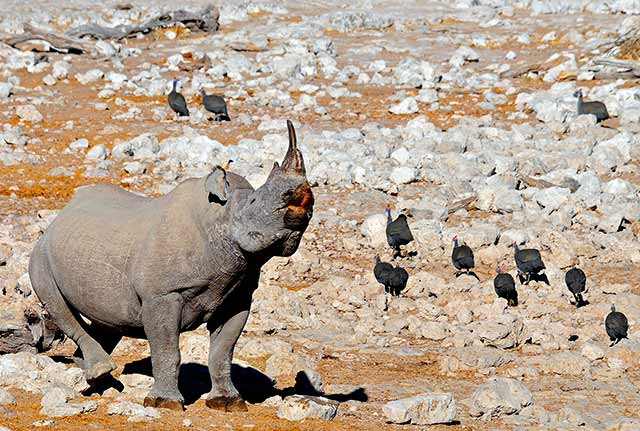
© 2013 Jennifer Fazekas. All rights reserved.
Black Rhino – Etosha National Park, Namibia
Nikon D300 with Nikon 80-400mm AFS lens @ 280mm on tripod.
ISO 400, f/6.5 @ 1/1000 sec.
So then how do you locate these animals when on a photo safari!?
There are two types of photo safari s – a self-drive safari or guided safari. If you go on a guided safari the guide has the responsibility to find the animals, but we have been on many guided game drives and on some of these we have seen few animals, even at 5-star lodges. There are just no guarantees! If you are, however, prepared to pay up to US $1000.00 per person per night at one of the exclusive lodges, they will pretty much take you to whatever animals you want to see. They either have rangers tracking the big-five animals every day or they have previously micro-chipped the elusive animals (inserted a small electromagnetic tracking device under the animals skin) so that they can pin-point their positions on a daily basis.
OK, so you cannot afford these high prices, so now what?
A self-drive safari can also be very rewarding in terms of finding and photographing exciting subjects – if you know what to do.
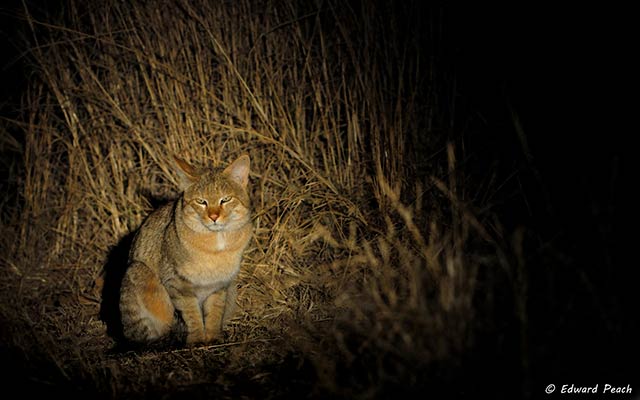
© 2013 Edward Peach. All rights reserved.
African Wild Cat – Pilanesberg National Park
Nikon D90 with Nikon 200-400mm lens @ 200mm on beanbag. ISO 1250, f/4 @ 1/125 sec.
Here are our top ten tips on finding animals on an African photo safari:
1. Bring a set of binoculars and keep them in the vehicle close to you. A lot of people keep them in the trunk (or boot) of the vehicle and then cannot get to them while driving. Keep them handy so you don’t miss out on finding that distant animal.
They are also very handy at viewpoints, in camps and at waterholes. If you don’t have binoculars or a spotting scope, then just use you telephoto lens to check for far-away subjects.
2. Use Sighting boards. These are magnetic maps upon which visitors place coloured markers to show other visitors where they saw the big-five animals and other interesting subjects. In the Kruger National Park every camp and park gate has a sighting board. In the Kgalagadi the main camps have sighting boards and in the wilderness camps they have sighting books in each unit. In Etosha there are sighting books at each camp reception, and the Pilanesberg has ‘Parkview’ – an electronic sighting board that has a history of sightings going back two years!
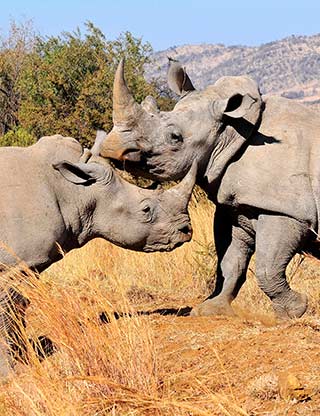
© 2013 Jennifer Fazekas. All rights reserved.
White Rhinos – Pilanesberg National Park
Nikon D300 with Nikon 80-400mm AFS lens @ 92mm on Apex beanbag.
ISO 400, f/10 @ 1/800 sec.
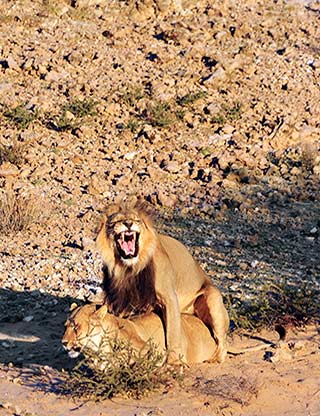
© 2013 Mario Fazekas. All rights reserved.
Mating Lions – Kgalagadi Transfrontier Park
Nikon D3S with Nikon 80-400mm AFS lens @ 330mm handheld. ISO 1100,
f/8 @ 1/1000 sec.
3. When to visit? The time of year and time of day is important when planning your visit to Africa. The winter and spring months (June to October) are the best times for finding animals in African parks, as the grass is very low and thin. Plus, the animals are forced to come to water sources to drink. Then for game drives, the best time of day is early morning and late afternoon as the animals are more active and the light is much better for photography!
4. Speak to your neighbours in the camps and speak to the safari guides when you see them. Most people will not tell you what they saw and where, unless you ask them!
5. The Kruger Park, being one of the biggest and most famous African Parks, has an app called “Kruger Sightings”. When visitors see something, they upload the text and/or image to the Facebook page or website. If you have an Android or iPhone app, the notification comes to your phone if there is a signal.
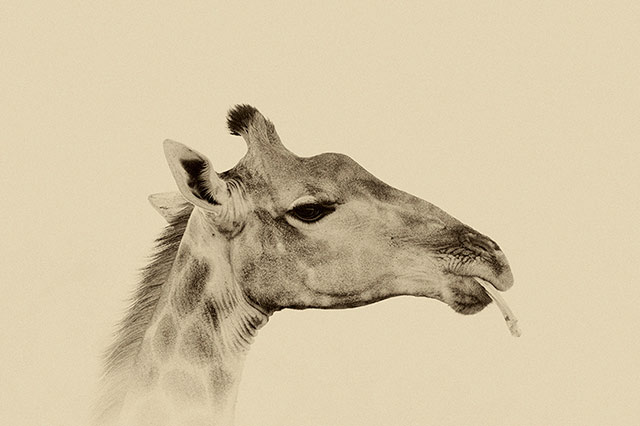
© 2013 Mario Fazekas. All rights reserved.
Giraffe Sucking Bone – Kruger National Park
Nikon D3S with Nikon 600mm f4 lens on Apex beanbag.
ISO 1600, f/8 @ 1/250 sec.
6. While driving look ‘through’ the bushes and not ‘at’ the bushes. Look for flashes of colour, motion and odd shapes. Use your other senses as well – listen for alarm calls! If you smell something bad, it could be a carcass with predators!
7. We suggest driving slow – between 25 and 35 kilometers per hour (15-20 mph) on both tar and dirt roads. This will ensure you don’t speed past an animal without seeing it. We have observed visitors driving right on by the elephants and giraffes without ever noticing them!
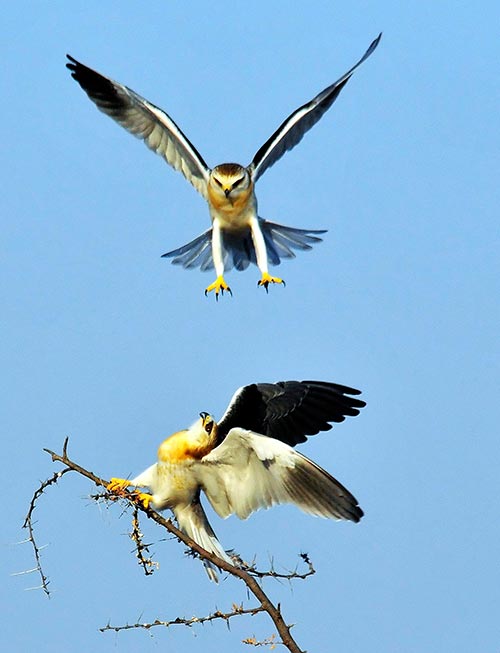
© 2013 Mario Fazekas. All rights reserved.
Black-shouldered Kites – Etosha National Park, Namibia
Nikon D300 with Nikon 80-400mm VR lens @ 400mm on Apex beanbag.
ISO 560, f/9 @ 1/1250 sec.
8. Try and stay at least 3 days at each camp. You’ll want to give yourself the time that is needed to not only get a feel for the animal locations, but be able to make photographs of a wide variety of wildlife. And who wants to spend all that valuable time packing and unpacking!
9. Read up a bit on animal behaviour so that you understand their habits and the most likely habitat in which to find them. This will make locating the subjects much easier and you will be better prepared to anticipate potential actions and behaviours.
10. Invest in a book or site-guide that explains items like: the best routes to take, where the most active waterholes are, the best time of day to see and photograph, and what resident animals you can expect to see.
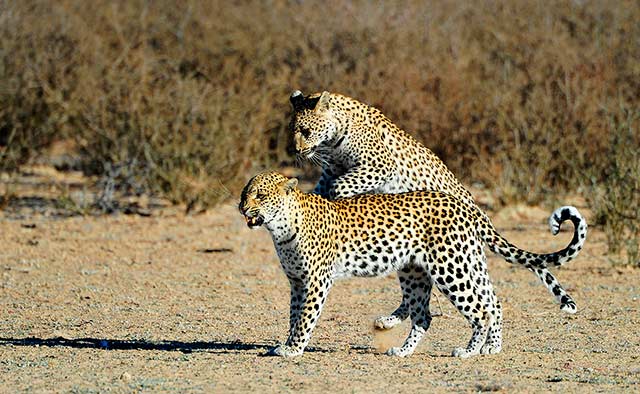
© 2013 Mario Fazekas. All rights reserved.
Leopard Mother with Cub – Kgalagadi Transfrontier Park
Nikon D3S with Nikon 80-400mm AFS lens + 1.4x tele-converter @ 560mm
on Apex beanbag. ISO 560, f/8 @ 1/1000 sec.
Having a successful photo safari very much depends on whether you can find the wildlife – this is your biggest challenge! If you apply the above ten tips you should easily find the big-five animals and more. Then it’s up to you to know how to use your photo gear to create those great images!
THE PARKS:
The Kruger National Park
Location: The Park is situated in north-eastern South Africa, bordering Mozambique and Zimbabwe.
Access: By road or air.
Facilities: There are over 20 park camps with accommodation ranging from camping, tents and chalets to large guest houses. In addition, there are five-star lodges in concessions within the park and in private game reserves outside the park forming the ‘Greater Kruger Park’.
Reservations: Can be made online on the SANParks website and directly with the private lodges.
Locating Subjects: There are sighting boards at all the park camps, park gates and at some shops.
Kgalagadi Transfrontier Park
Location: The Park is situated in South Africa in the Northern Cape along the Namibia and Botswana borders.
Access: By road or by air. A 4×4 is recommended for driving in the park as the roads are corrugated.
Facilities: There are three main camps, six wilderness camps, and one luxury camp on the South African side and two luxury camps on the Botswana side providing accommodation from camping to luxury chalets.
Reservations: Can be made online on the SANParks website or directly with the private lodges; Transfrontier Parks Destinations in South Africa (!Xaus Lodge) and Ta Shebube in Botswana (Rooiputs Lodge, and Polentswa Tented Camp).
Locating Subjects: There are sighting boards at the three main camps and sighting books at the wilderness camps and private lodges.
Pilanesberg National Park
Location: The Park is situated in the North-West Province of South Africa in the remains of a volcano.
Access: By road or by air.
Facilities: There are seven main lodges in the park ranging from three to five stars and the accommodation choices are camping, tents or chalets.
Reservations: Can be made online with the various lodge groups – Legacy, Golden Leopard, Pilanesberg Private Lodge and African Anthology.
Locating Subjects: There are electronic sighting consoles at most of the park lodges.
Etosha National Park
Location: The Park is situated in northern Namibia on a huge salt pan.
Access: By road or by air.
Facilities: There are five camps in the park and many private lodges outside the park providing accommodation from camping to chalets.
Reservations: Can be made online via NWR and with the various private lodges.
Locating Subjects: There are sighting books at all the park camps and at the private lodges outside the park.
We so wish we had park-specific eBooks to buy when we first started visiting the national parks. We had to endure a long learning curve on safari after safari, finding out the most productive routes, learning animal behaviour and animal hot-spots, making mistakes and going back to try and rectify them and so on!
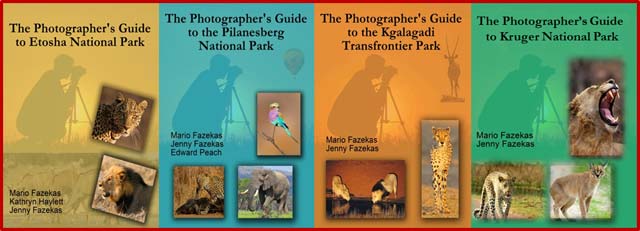
by Mario Fazekas
Photos: © 2013 Mario Fazekas, Jennifer Fazekas and Edward Peach. All rights reserved.

Leave a Reply